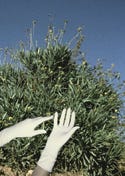ASTM Creates New Category for Natural-Rubber Latex
NEWS TRENDS
August 1, 2006
|
Guayule and other natural-rubber latices are free of allergenic proteins found in tropical latex. |
ASTM has created a new category for natural-rubber latex that is based on its protein content. Category 4 of ASTM D1076-06 pertains to guayule and other natural-rubber latex that has less than 200 µg of total protein per gram dry weight of latex. Recognizing that natural-rubber latex is free of the allergenic tropical proteins could be a step forward for manufacturers looking to use high-performance latex.
Before the new category, the only ASTM standard specification for rubber pertained to ammonia-preserved, creamed, and centrifuged natural latex. All of these forms of rubber-concentrated raw-material latex measured physical performance rather than protein content. It also applied to Hevea-based raw materials that came from tropical rubber trees in Southeast Asia. Tropical latex has been responsible for moderate to severe allergic reactions for years.
|
The ASTM standard could help OEMs use high-performance latex in their products. |
Yulex Corp. (Carlsbad, CA) currently makes the only natural latex that falls into the new category. It is made from guayule, a desert plant found in the southwestern United States. Yulex provides the material to device manufacturers through its distribution agreement with Centrotrade USA and Centrotrade Deutschland GmbH. “We've been looking to differentiate domestic latex, or guayule latex, from tropical latex, or Hevea latex,” says Jeffrey Martin, president and CEO of Yulex. “Our concern with introducing our latex into the market was that we would be grouped into that [tropical latex] category, and people would not look at us as a feasible alternative for sufferers of latex allergies.” Prior to the new category, Martin says that manufacturers were confused over which category the Yulex rubber fit into.
Martin speculates that the new category will drive other latex manufacturers to move toward using natural rubber that contains no tropical proteins. “I think it puts pressure on the medical latex industry to do a better job with respect to providing safer products to the marketplace,” says Martin.
The new category also contains high-performance standards for the material based on its natural elasticity, elongation properties, barrier protection, tensile strength, and durability.Copyright ©2006 Medical Device & Diagnostic Industry
About the Author(s)
You May Also Like



